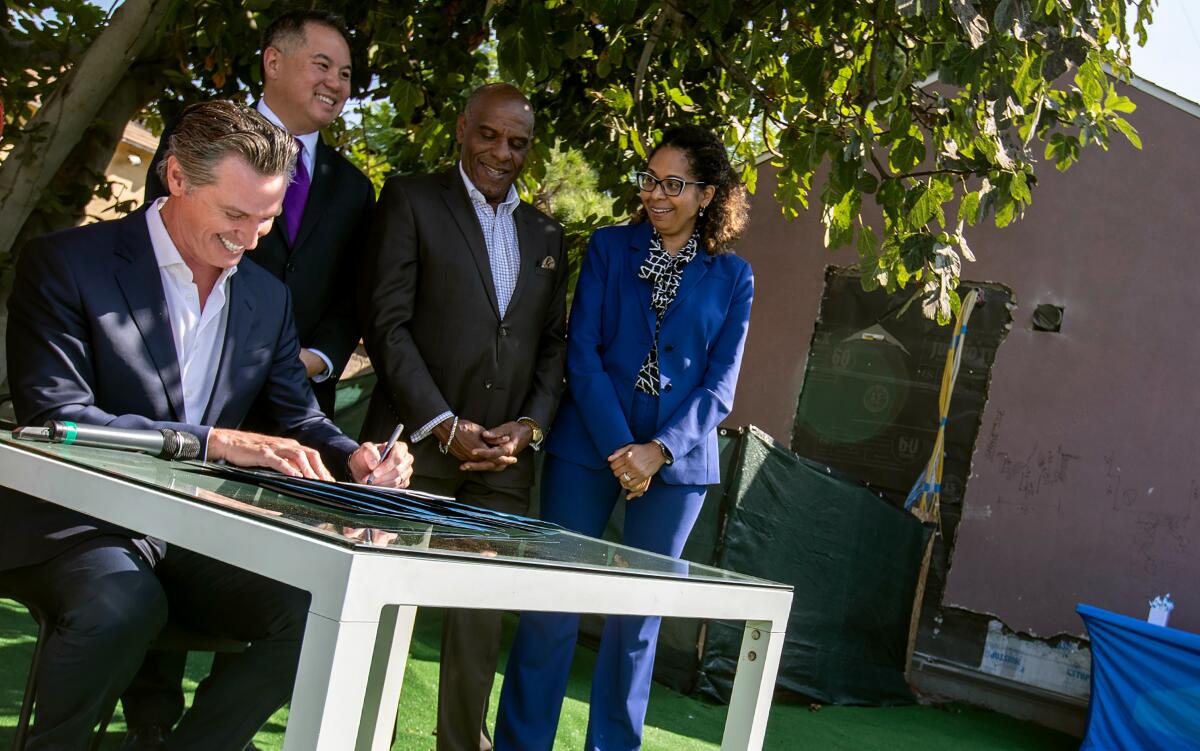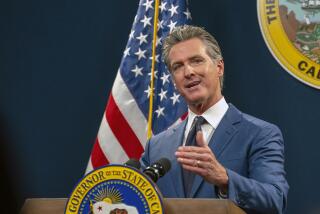Q&A: Gov. Newsom claims success in first year of addressing California’s housing crisis

Nearly one in five Californians live in poverty — the highest rate in the nation — when factoring in the cost of housing. Gov. Gavin Newsom has made addressing the state’s housing affordability crisis central to his platform as governor. Interviewed for a story on his promises and accomplishments on housing after the state Legislature adjourned for the year, this is what he told The Times.
The transcript has been edited for length and clarity.
Liam Dillon for The Times: How would you assess your year in housing?
Newsom: I think it was focused. It was intentional. It’s a stubborn issue. You can’t snap your fingers and build hundreds of thousands, millions of housing units overnight. I think we set the table on a lot of critical issues, like tax credits, revolving loan funds, enhanced infrastructure financing.
The reality is this is not going to all change in the first nine months [or] 10. We’re going to continue to have to do more and better variants of how we can work with SB 50 [a bill to increase housing density in single-family neighborhoods and around transit]. What can get through the Assembly and the Senate. It’s one thing to idealize something, but there’s been two rounds of this and so we’re working to do what we can through the budget and legislatively next year — we’re already working on that — to see if we can take aspects of SB 50 that we think we can help navigate through.
The Times: During your inaugural speech, you called for a “Marshall Plan” on affordable housing. Have we gotten that?
Newsom: We could brand it as such.
I’m not naive. I get the Marshall Plan says everything else ceases and everything else stops. It connotes something perhaps broader and bigger. But the sum total of these efforts and the judicious way that we broke down these pieces, and we implemented and we strategized and we were able to capitalize on the energy, particularly around the budget, are examples of that.
But, clearly, the broader issue that would get into issues of NIMBYism and land use that are the thrust of what would be construed as a Marshall Plan. Those remain in front of us. We’re committed to doing a lot more.
The Times: When I hear Marshall Plan, I think money. We’re still talking, per the legislative analyst, multi-billion dollars perhaps tens of billions of dollars away from what you would need to subsidize housing for the neediest. Is there more of a money component that you’re hoping to do in future years?
Newsom: I never looked at it exclusively as a money issue. By any stretch. The state is not going to subsidize a way out of it. Anyone who believes that is fooling themselves or at least fooling others that the state can find itself in that position. I mean $2.75 billion of new money in homeless and housing is not insignificant. Certainly, I’m not denying the importance of making those kinds of investments.
But it’s the private sector that has to be stimulated. It’s creating the conditions for billions and billions of dollars in private-sector investment. That’s the fundamental piece that’s missing. Rent caps are also a part. It’s a production and preservation strategy, as you saw this year. I don’t think it was small ball, that rent cap.
The Times: The thing that you referenced a lot, or prominently on the campaign trail, was 3.5 million new homes, 500,000 a year. The new numbers for this year look like they’re trending in the opposite direction: Fewer homes than what was built in 2018. Is 3.5 million, is that still your plan?
Newsom: I don’t know how many times I have to say it. You’ve heard me say it a hundred times. I’ll say it 101 — 3.5 million is the number. And I said it as clearly as I possibly could when announcing on the campaign trail, it’s the honest number that most of the experts agree is the number that actually can substantively address the affordability crisis.
I said it’s a stretch goal. It’s an audacious goal. I think I quoted Michelangelo: The biggest risk is not that you aim too high and miss it. It’s that you aim too low and reach it.
We want to be accountable and transparent. But we also made this point, and you heard me say it again just last week, the focus on these [regional housing] goals being updated, and then getting a number out there that is a short-term and medium-term number. Not just a stretch goal, but some really different, pragmatic, regional goals.
The Times: You’re saying you’re not backing away from the 3.5 million number, but there’s going to be a more official, if you will, state number that I suppose will be the sum total of all the [regional housing] allocations that are going to be coming out?
Newsom: Yeah.
The Times: I spoke with Ben Metcalf, your former housing director. I asked him to evaluate you on this. I know you’ve heard this a lot. The idea that you wanted to do a lot of things in a lot of different areas, that making it hard to focus on individual subjects. Would you agree that housing falls into that argument as well?
Newsom: Absolutely not. I don’t understand this. Everything we laid out in terms of the specific goals and details we were able to achieve getting through the budget, the vast majority.
The Times: Well, taking transportation money that was something that was changed significantly to something that was much weaker than that.
Newsom: That was an audacious goal. We went way out on a limb on that and we were able to get in that trailer bill I think some very good language. That pushed us a lot farther than anyone thought we could go.
The Times: The suggestion is that you made a number of promises not just in housing, of course, but in healthcare, in education, in public safety — a huge portfolio. As a result, making all those promises in so many different areas makes it hard to focus on or choose specific areas to go deep on because you have so many priorities.
Newsom: I totally reject that. We could take each one. We laid out what we wanted to accomplish year one on healthcare. We were able to go deep and deliver on it. We were able to lay out very detailed terms on what we wanted to accomplish on education in the first year. I think we delivered on those. Specifically on the issue of criminal justice reform, helping to negotiate the use of force. I think it’s a limiting mindset this notion that you can’t go deep on multiple topics.
The Times: Let me try to frame this another way. I know from talking to lawmakers that there was not a lot of clarity from them on where you were on SB 50 until after it was held and you put the statement out saying you were “disappointed” in it being held. The same earlier on with some of the tenant stuff. Towards the end, certainly everyone says that when you folks became fully engaged on the rent cap legislation that’s what changed it into something that was much stronger.
Newsom: We do what we can do. Not everything can be done overnight. Not everything can be done in a few months. I feel like we had a good year. And I also feel that we have a hell of a lot of work to do. By no stretch of the imagination are we done. This is not an issue that we’re going to get distracted on. I am all in on the issue of affordability. We have many, many next acts. Stay tuned.
The Times: Are you familiar with the court case, this is with respect to homelessness specifically, the court case out of Boise?
Newsom: Yeah. I’ve been reading some interesting articles saying, ‘This small town in Idaho ...’
The Times: Do you support overturning that decision? That decision currently prohibits cities from ticketing and arresting homeless people for sleeping or camping on public property if there’s no beds that are available.
Newsom: Yeah, I don’t know enough about the details to honestly opine about it. But I do think, as a former mayor, you need tools to encourage people. I don’t think you can just moralize and idealize this and hold a candlelight vigil and hope and pray. That’s sort of suggestive that I think local governments need tools. Otherwise, the streets become completely overtaken by campsites, etc. You can’t run a city like that. You can’t run a community like that. You just can’t.
The Times: I understand this is your first year. But you did make a lot of promises in this area. What we’re seeing is the homeless population is up. [Housing] permitting is slowing. It seems like things are getting worse. How do you respond to that now that you’re the person in charge?
Newsom: I focused on these things. I campaigned on these things, and we hit the ground running on these things. You may recall that the week I took the oath of office, those numbers you referred to became public.
The Times: The homeless [point-in-time count] numbers?
Newsom: Yeah. You say it’s gotten worse. I caution you before you say that to consider that those numbers came out the same week that I was sworn in. Hold me accountable, but give me more than three days. Those were last year’s numbers that were made public this year. Profoundly important.
On the housing starts stuff. We’re nine months in. OK, I get it. You had some fires and some setbacks on permits. You have to net some of that out. You inherit trend lines. Not everything starts and resets the minute you get in. In two or three years and the numbers keep going up is one thing, but to somehow connect the dot that it’s gotten worse since we started. I don’t know that you can make that claim.
The Times: But it does put you in a deeper hole than perhaps you might have been this time last year.
Newsom: I spent months and months putting together a series of policy papers, prescriptions on this. We’re hitting on a lot of those things. Some of them are a little more difficult.
I wish to hell the last 20, 30 years we were more focused on these things. Because respectfully it takes decades to create these conditions. This is years and years of underdevelopment. It manifests. Homelessness has been around since the late ‘70s, ‘80s. We can connect dots to behavioral health issues, federal government. All kinds of issues that made this a stubborn issue growing pretty consistently with a couple years [of] exceptions.
We’ve gotta jump on this stuff. I’m the governor. You’re going to hold me accountable. I love you, but I’ve read this article before. I know what’s coming out.
The Times: OK.
Newsom: I’m a grown-up. I own it. I’m not walking away from it. I’m not abdicating responsibility and accountability. But I got 470 cities that are partners. I’ve got a lot of city administrators, members of county supervisors. We all have to row together. The state can’t do the job of every city. If they want me to, we’re happy to. I’m happy to be mayor of California. But I’m not mayor of California. I’m the governor. That’s the balancing act here.
More to Read
Sign up for Essential California
The most important California stories and recommendations in your inbox every morning.
You may occasionally receive promotional content from the Los Angeles Times.











